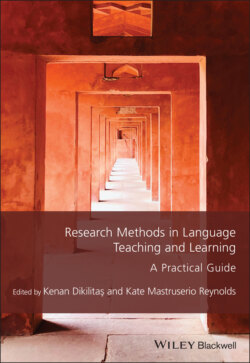Читать книгу Research Methods in Language Teaching and Learning - Группа авторов - Страница 53
Data Collection Methods
ОглавлениеGrounded theory is flexible in terms of data collection methods and permits researchers to use any methods that serve the purpose of developing a theory. Researchers can change their methods at any point during research (Charmaz, 2006) to attend all important constructs emerged from data. During research interventions, we shifted the focus of observations and interviews from revealing students’ characteristics and instructional problems to understanding their reactions and classroom behaviors. This led to collecting richer and more relevant data.
In grounded theory, it is important to reach data saturation: collecting data until it stops producing new topics, ideas and categories (Morse, 2007). Data saturation is the point where researchers ensure that further data will not add new knowledge. This is important to develop a thorough understanding of the phenomenon. However, reaching data saturation was not possible in this research because I had to complete the research in one term.
Another important aspect of collecting data in grounded theory is using “comparative methods” (Charmaz, 2006). Considering that it may not be appropriate to develop theories by relying on the data that emerged from one data collection method, researchers are encouraged to use “methods triangulation” in order to check the consistency of findings generated by different data collection methods (Patton, 1980). This argument shows the complexity of developing a theory, in that it requires understanding the phenomena from different perspectives by using different data sources. We addressed this assumption in selecting our data collection methods.
Three data collection methods were used in the study: observation, questionnaire, and interview. In Stage 1, which lasted 4 weeks, the methods were employed to become familiar with the classroom situation. In doing so, we sought an answer to the first questions that grounded theory should ask, “What’s happening here?” (Glaser, 1978). This made it possible to uncover problems that hindered the effectiveness of classes and to identify issues to address in the study. In doing so, as suggested by Hopkins (2008), questionnaires were used to gather broad and rich information regarding different aspects of classroom. Although using questionnaires is not common in action research studies, McNiff et al. (1996) maintained that it is appropriate when the information cannot be ascertained otherwise. Considering that conducting interviews with 32 students throughout the term would be difficult, a questionnaire was a convenient method for collecting data from the whole class. The questionnaire included open- and closed-ended items and comprised four main sections: (a) personal information, (b) EFL learning experiences and perceived EFL competence, (c) self-evaluation, and (d) views about the ideal speaking class. In this stage, I observed classes to describe the setting from my perspective (Patton, 1980). Observation provided “live data” (Cohen et al., 2007, p. 396) and made it possible to record “non-verbal behavior in natural settings” (Bailey, 1994, p. 224). These helped me analyze learners’ reactions during speaking activities and select my interviewees. My observation was nonparticipant and I made field notes to record comments that I believed to be important (McKay, 2006). After analyzing the questionnaire and observation data, interviews were implemented as they are useful when investigating how individuals make sense of their experiences (Brown & Dowling, 1998). These were follow-up interviews and were based on the data collected through observation and questionnaire, in that participants were asked to elaborate on their classroom reactions and responses to the questionnaire. These data enabled me to gain an in-depth understanding of these areas.
Stage 2 was the intervention stage, where student negotiation was implemented on a weekly basis for 8 weeks. I observed these sessions to record significant events and student behaviors in the classroom. In this stage, post-session methods were implemented after each intervention: post-session questionnaires were administered to students and the teacher, and follow-up interviews were conducted. These methods aimed to understand participants’ viewpoints regarding the effectiveness of the session. Students were also asked to provide information about their perceived participation in the session. These data gave me some ideas about what issues to take into account to improve the effectiveness of my follow-up research intervention.
Stage 3 was carried out in the final week of the term with the aim of developing an understanding of participants’ perspectives of their experiences of student-negotiated speaking classes; this stage involved a student final questionnaire, a teacher final questionnaire and student final interviews. The student final questionnaire included a number of items similar to the initial questionnaire in order to discover whether these issues differed after experiencing student negotiation. In addition to these, students were asked to make comments about their experiences of student-negotiated speaking classes. In the final interview with the teacher, the teacher was invited to evaluate the term with respect to student participation and performance. They were also asked to comment on the effectiveness of student negotiation and the present action research project. The student final interview had a number of questions that were the same as those in the student initial interview, the aim being to see whether research interventions had had an impact on certain areas. Students were also asked to offer their opinions about the positive and negative aspects of using student negotiation in EFL speaking classes.
